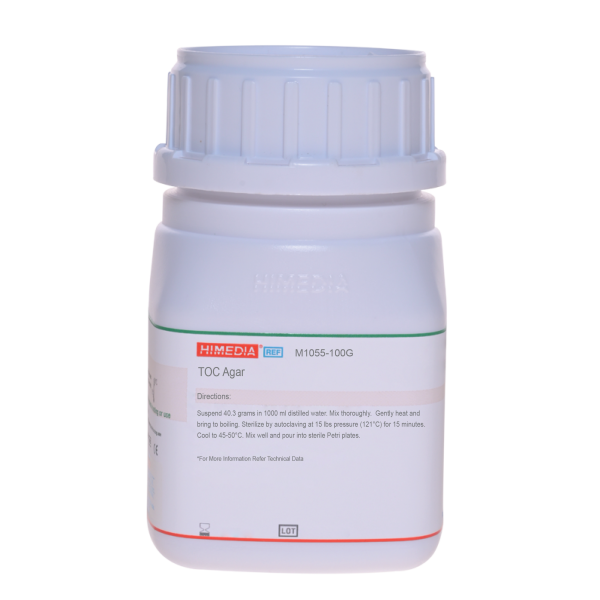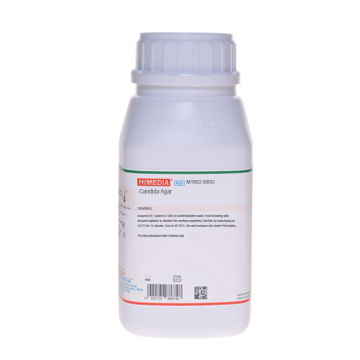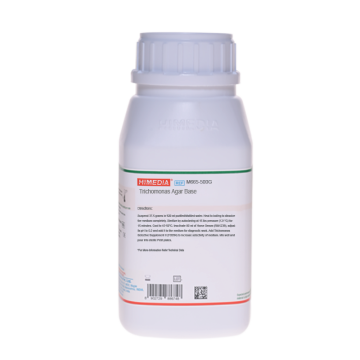 Your enquiry has been submitted
Your enquiry has been submitted
TOC Agar
TOC Agar is a differential medium used for the presumptive identification and differentiation of Candida albicans and Cryptococcus neoformans.
Composition
| Ingredients | Gms/Litre |
|---|---|
| Ox bile | 10.000 |
| Sorbitan monooleate 80 | 10.000 |
| Caffeic acid | 0.300 |
| Agar | 20.000 |
Final pH (at 25°C): 6.5±0.2
Formula adjusted, standardized to suit performance parameters
Directions
Suspend 40.3 grams in 1000 ml distilled water. Mix thoroughly. Gently heat and bring to boiling. Sterilize by autoclaving at 15 lbs pressure (121°C) for 15 minutes. Cool to 50°C and pour into sterile Petri plates.
Principle And Interpretation
Candida are yeast-like fungus forming normal flora inhabiting the mouth and throat, the intestinal tract and the genital tract. Under certain conditions, they cause life-threatening diseases particularly in immunocompromised patients.
Candida albicans is the species most commonly isolated from patients with nearly all forms of candidiasis. Cryptococcus neoformans is often cultured from the urine of patients with disseminated infection. Cryptococcosis is one of the defining diseases associated with AIDS (1). TOC Agar is a multi-purpose medium developed by Fleming et al (2) for the rapid, presumptive identification of C. albicans and C. neoformans. Both species are common clinical isolates that may be presumptively identified by specific morphological characteristics (3-7).
C. albicans and C. stellatoides may be presumptively identified on this medium by the formation of germ tubes and chlamydospores (2, 5). A combination of sorbitan monooleate 80 and oxbile promotes their rapid, sequential development. C. neoformans may be identified by the production of a characteristic brown pigment on this medium (2, 5). Caffeic acid is the substrate for phenol oxidase, an enzyme produced only by C. neoformans (2). The subsequent enzymatic reaction produces melanin, which is absorbed by the yeast cell wall resulting in tan to brown pigmentation.
For the germ tube test, lightly touch a single colony from TOC Agar with a loop or Pasteur pipette; remove excess inoculum and then emulsify the yeast cells in 0.5 ml of horse or other serum in a small test tube with a loose cotton-wool plug. Failure to achieve a light inoculum inhibits germ-tube formation. Incubate at 37°C in a water bath for 2-4 hours (8). A drop of suspension is then placed on a glass slide and covered with coverslip. Microscopic examination of typical C. albicans reveals thin germ tubes 3 to 4 mm in diameter and up to 20 mm long; unlike pseudohyphae that are not constricted at their point of origin.
Quality Control
Appearance: Cream to yellow homogeneous free flowing powder
Gelling: Firm, comparable with 2.0% Agar gel.
Colour and Clarity of prepared medium: Yellow coloured clear to slightly opalescent gel forms in Petri plates.
Reaction: Reaction of 4.03% w/v aqueous solution at 25°C. pH: 6.5±0.2
pH: 6.30-6.70
Cultural Response
M1055: Cultural characteristics observed after an incubation at 30°C for 24-48 hours.
| Organism | Growth Cultural Response |
|---|---|
| Candida albicans ATCC 10231 | luxuriant(Formation of germ tubes within 3-4 hours and chlamydospores within 48 hours) |
| Cryptococcus neoformans ATCC 32045 | luxuriant(Brown colony growth within 48 hours of incubation) |
Storage and Shelf Life
Store below 30°C in tightly closed container and the prepared medium at 2 - 8°C. Use before expiry date on the label.
Reference
- Murray P. R., Baron J. H., Pfaller M. A., Jorgensen J. H. and Yolken R. H., (Ed.), 2003, Manual of Clinical Microbiology, 8th Ed., American Society for Microbiology, Washington, D.C.
- Fleming W. H., Hopkins J. M. and Land, 1977, J. Clin. Microbiol., 5:236.
- Lennette E. H., Balows A., Hausler W. J. and Shadomy H. J.,(Eds.), 1985, Manual of Clinical Microbiology, 4th Ed., ASM, Washington, D.C.
- Finegold S. M. and Baron E. J., 1986, Bailey and Scotts Diagnostic Microbiology, 7th Ed., The C.V. Mosby Company, St. Louis.
- MacFaddin J. F., 1985, Media for Isolation-Cultivation-Identification-Maintenance of Medical Bacteria, Vol. 1, Williams and Wilkins, Baltimore.
- Campbell M. C. and Stewart J. L., 1980, The Medical Mycology Handbook, John Wiley and sons, New York.
- Ajello L., Georg L. K., Kaplan W. and Kaufman L., 1963, Laboratory Manual for Medical Mycology, DHEW Publication No. 994, US Govt. Printing Office, Washington, D.C.
- Collee J. G., Fraser A. G., Marmion B. P., Simmons A., (Eds.), Mackie and McCartney, Practical Medical Microbiology, 1996, 14th Edition, Churchill Livingstone.
| Product Name | TOC Agar |
|---|---|
| SKU | M1055 |
| Product Type | Regular |
| Physical Form | Powder |
| Origin | Animal |
| Packaging type | HDPE |
| References | 1. Murray P. R., Baron J. H., Pfaller M. A., Jorgensen J. H. and Yolken R. H., (Ed.), 2003, Manual of Clinical Microbiology,8th Ed., American Society for Microbiology, Washington, D.C. |
| Customized Product Available | No |







